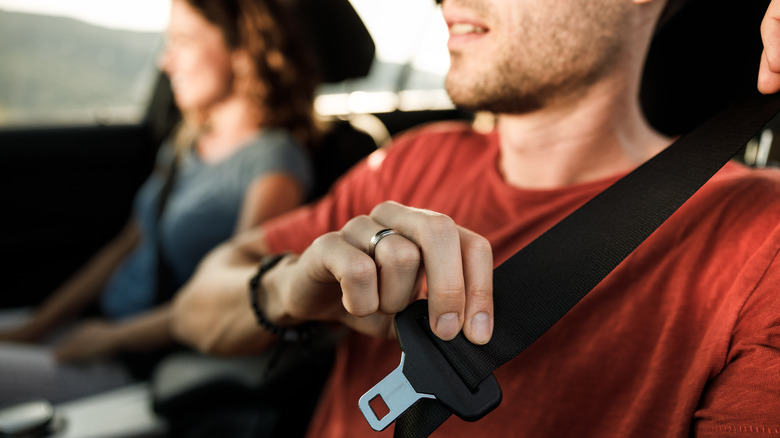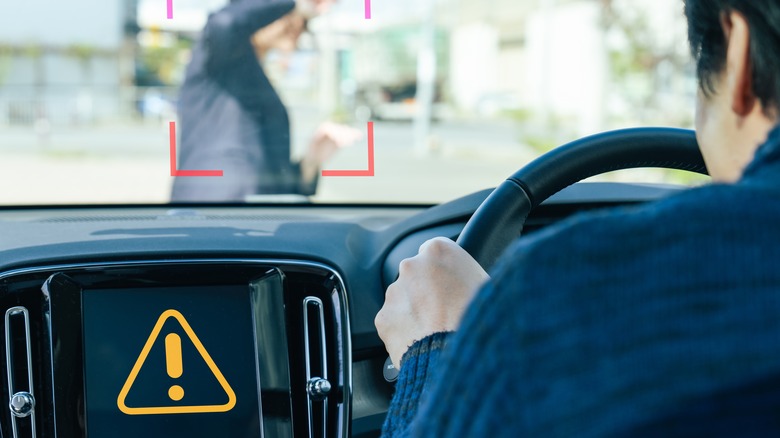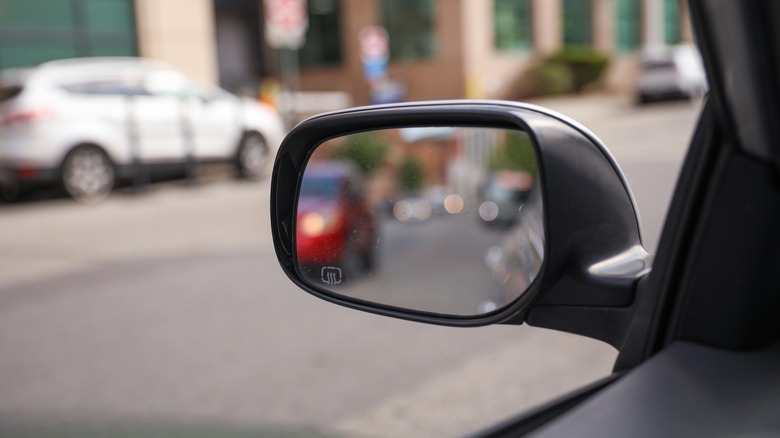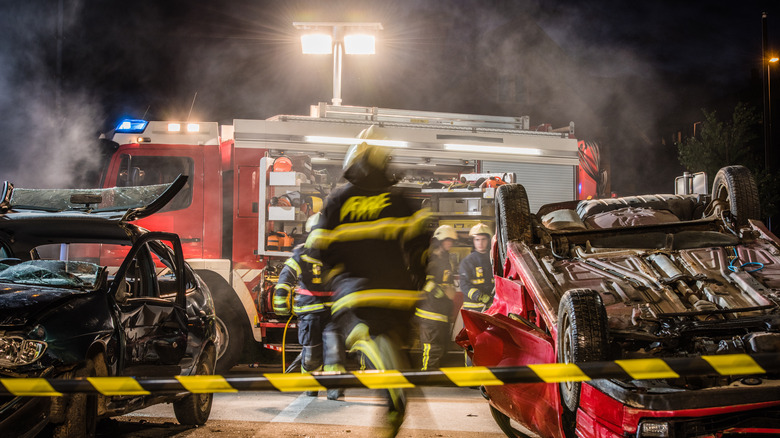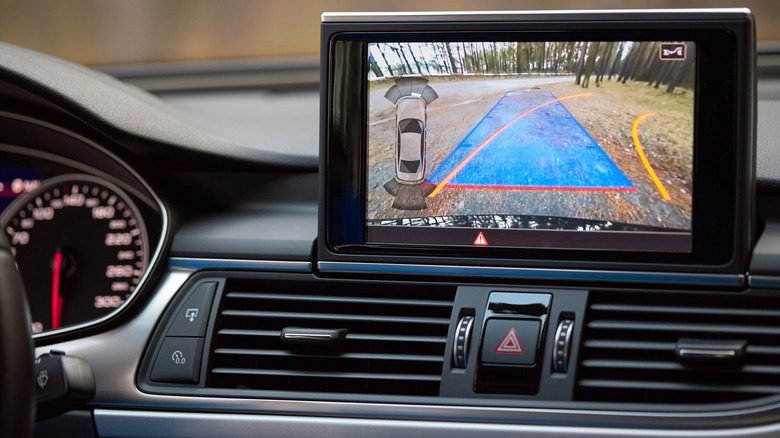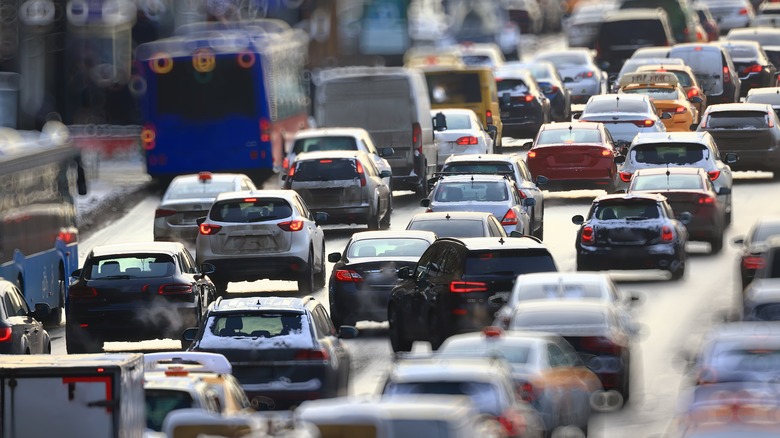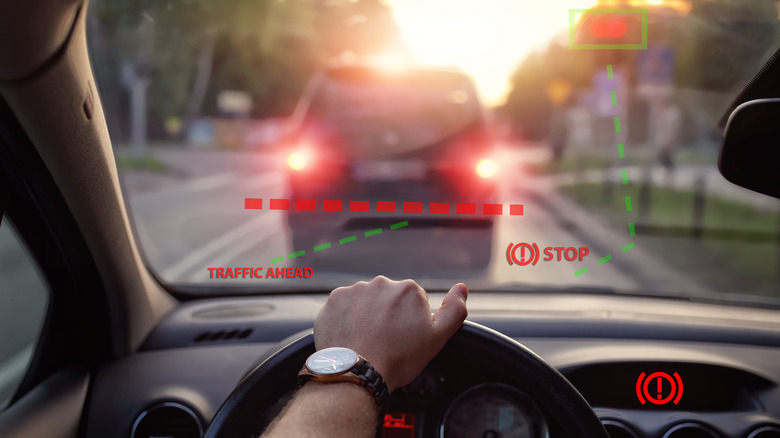7 Of The Best Modern Car Safety Features Available Today
Most of us have a good idea of what we want when we step onto a showroom floor when shopping for a new car. For some, lots of cargo space is a must, while for others, it's a user-friendly infotainment system. While it may not be at the forefront of our minds, car safety features are something we'd all do well to prioritize when looking for a new car. That's they not only minimize our chance of getting into a serious accident but also substantially lower our risk of injury.
When we talk about car safety features, we're referring to anything designed to help prevent accidents or lessen a crash's impact. Government-mandated features like airbags, seatbelts, and antilock brakes are just a few that come to mind when most of us think of car safety. You expect these features to come standard on any modern car and probably don't give them a second thought.
But modern car safety is about a lot more than just surviving a crash — it's about avoiding one altogether. That's why car manufacturers are constantly adding to the list of features to help keep us safe on the road. And these advanced safety features are no longer limited to luxury cars — many are now available across a range of vehicles at different prices.
Automatic emergency braking with pedestrian detection
Most drivers have had to slam on the brakes at some point. Maybe a child stepped out onto the street unexpectedly, or a car ran a red light just as you were about to cross the intersection. These split-second decisions can make the difference between a close call and a serious accident. We don't always have enough time to react in time to prevent a collision, but if your car comes with automatic emergency braking, it'll have your back in these situations.
Automakers won't be required to include automatic emergency braking in new passenger cars until 2029. However, vehicles like the 2025 Honda Civic SI and the luxurious 2024 Kia Telluride already come with the technology. Automatic emergency braking uses radar, cameras, or lidar to detect a potential collision and automatically apply the brakes if you don't react in time. The technology works best during the day, and also when traveling under 25 mph, making it effective at preventing daytime crashes in parking lots and urban areas where heavy traffic is common.
While full-speed automatic emergency braking has become more common since 2020, at high speeds it's only effective at slowing a car down, not stopping it. When the new standard mandating all vehicles be sold with automatic emergency braking goes into effect, it will have to stop cars going up to 62 mph, and must also include pedestrian detection, which will let cars identify and react to pedestrians both day and night.
Blind-spot collision warning
When we learn how to drive, we're constantly reminded to check the blind spot before changing lanes or merging into traffic. A vehicle's blind spot is the area around the back and sides of your car that you can't see by just checking your mirrors. Blind spots make it hard for us to see cyclists, pedestrians, or other vehicles approaching, increasing the risk of accidents. Blind-spot collision warning systems act as an extra set of eyes, detecting cars in hard-to-see areas and letting us know they're there before we change lanes.
Blind-spot collision warning systems use your car's rear bumper sensors to monitor vehicles in areas that aren't in your field of vision when turning your head or checking your side-view mirrors. If the system identifies a car in your blind spot and you try to change lanes, it will warn you by flashing an amber light in the side mirror, sounding an alert, or vibrating the steering wheel, depending on your vehicle's make and model. While the government hasn't mandated the use of blind-spot collision warning systems in passenger vehicles, many cars, including the affordable 2025 Hyundai Elantra N and the sublime BMW Z4 M40i, come with this technology.
Automatic crash notification
If you get into a car accident, automatic crash notification lets first responders know your location, even if you're unable to do it yourself, so they can get to you faster. Automatic crash notification works with your car's built-in cellular connection or a paired phone, sending an alert as soon as it detects an accident. Some advanced automatic crash notification systems can do more than just call for help — they can let first responders know what type of injuries you and any passengers may have suffered, based on their assessment of the impact of the crash.
Automatic crash notification was once a subscription-based service. However, that's changing as more and more car manufacturers offer it free with new cars. It's one of the Toyota RAV4's hidden features and is also available on the fun 2025 Mazda CX-30 Turbo and other Mazda vehicles through the manufacturer's automatic 911 dialing service. Automakers that don't include automatic crash notification free with the purchase of a new car often offer buyers a several-years-long free trial. With automatic crash notification, you know that even if you're unconscious or unable to call for help after a collision, emergency services will be able to find you.
Electronic stability control
Electronic stability control has been standard in all vehicles sold in the U.S. since the 2102 model year, and the National Highway Traffic Safety Administration estimates that the technology saved more than 7,000 lives just between 2011 and 2015. Whether you buy a solid new 2025 Nissan Altima or are driving an older version, if your vehicle is a 2012 model or newer and you purchased it in the U.S., it came with this safety feature standard.
Electronic stability control's job is to help you keep your car steady and on the right path. It uses your car's sensors to track wheel speed, steering, and sideways motion. If the system detects you're losing control of the vehicle, it automatically adjusts the brakes and engine power to help keep you heading in the right direction. This is especially useful for vehicles with a higher center of gravity, like SUVs and pickup trucks, reducing the risk of fatal single-vehicle crashes and rollovers in them.
When driving, we encounter all types of obstacles before reaching our destination, and electronic stability control lets you swerve to avoid hitting an object and return to your lane safely without fishtailing or spinning out. You'll come across many names for electronic stability control while car shopping, with some of the most common being vehicle stability control, electronic stability program, and dynamic stability control.
Backup cameras
Unless you've only driven cars made after 2018, when backup cameras became mandatory in the U.S., you've had the unpleasant experience of twisting and turning your head as you back out of a parking space or garage, trying to ensure nothing was behind you. But it's just not possible to see everything behind you when backing up, whether we're talking about a toy that's out of sight or someone walking behind your car.
That's what makes backup cameras, also known as rearview cameras, so useful. They're positioned in the back of a vehicle, typically near the trunk or license plate, and are automatically activated when you put your car into reverse. Then you see what's going on behind your car on a display screen inside your vehicle. Before backup cameras became mandatory in new cars, the NHTSA estimated that nearly 300 people were killed and 18,000 injured each year in backover accidents.
Backup cameras have made it much easier for drivers to spot pedestrians and objects behind their vehicles when backing up. Most cameras have parallel lines corresponding to the car's width to help guide you as you back up. Advanced backup camera systems take it a step further with bending guidelines that move as you turn the wheel, giving you a clear idea of where your car is headed. For those with cars made before 2018, it's possible to install a highly rated backup camera system for your vehicle to improve visibility while backing up.
Lane-departure warning and lane-keeping assist
We've all seen a car drift into another lane without the driver being aware of it. Whether distracted by a car's infotainment system or simply tired after a long day's work, any of us could temporarily lose focus and stray from our lane. Lane-departure warning and lane-keeping assist help keep us in our lane so we arrive at our destinations safely.
While they sound similar and are often found together, they have different functions. As the name suggests, a lane-departure warning system alerts you when you're getting too close to a lane marker. Depending on the car, that warning can be a visual cue, a sound, a physical vibration, or all three. This safety feature uses a front-facing camera to track your car's position in relation to lane markers. It doesn't work when your vehicle's turn signal is on.
Lane-keeping assist is an advanced version of lane-departure warning, and many carmakers pair the two, calling it "lane-departure warning with steering assist." Where lane-departure warning just tells you that you're getting too close to a lane marker, lane-keeping assist intervenes, using your car's steering wheel to guide you back to your lane. Both systems are usually activated by default in vehicles that use them but can be deactivated, usually by pushing a button on the steering wheel. While automakers aren't required to include them, you can find them on the stylish, spacious 2025 Volkswagen Taos, the fuel-sipping 2025 Hyundai Sonata Hybrid, and many others.
Forward collision warning
If you've been driving long enough, you've likely had a close call where you had to slam on the brakes to avoid rear-ending someone. Rear-end accidents are especially common in urban areas, where stop-and-go traffic requires drivers to follow at a close distance, and there's often little room for error. That's where forward collision warning comes in, using a vehicle's front sensors to detect when a pedestrian or car is in a driver's path. Forward collision warning comes standard with many new vehicles, including the impressive but frustrating 2025 Chevy Blazer. However, the government has not yet mandated that all cars be equipped with it.
Forward collision warning works by alerting drivers when a car or object is directly in their path. The alert can come in the form of a visual warning, an audible alarm, a vibration in the steering wheel, or some combination of these. According to the Insurance Institute for Highway Safety, forward collision warning can reduce rear-end accidents by 27%.
Some systems include forward collision warning with pedestrian detection to alert drivers when a pedestrian crosses directly in front of their vehicle. While forward collision warning won't stop your vehicle if it detects a car in your path, it often works together with automatic emergency braking systems, which automatically brake if you don't respond in time.
